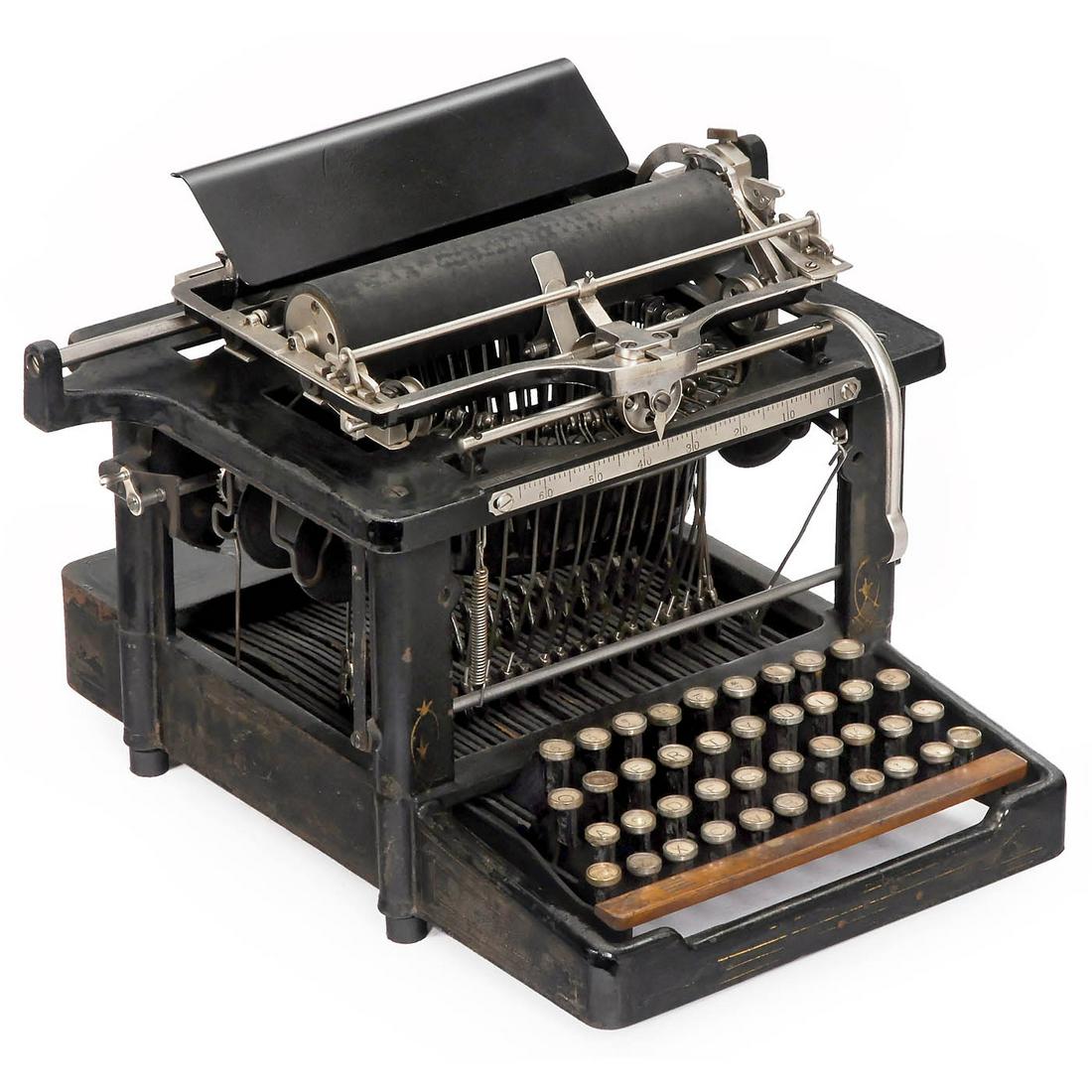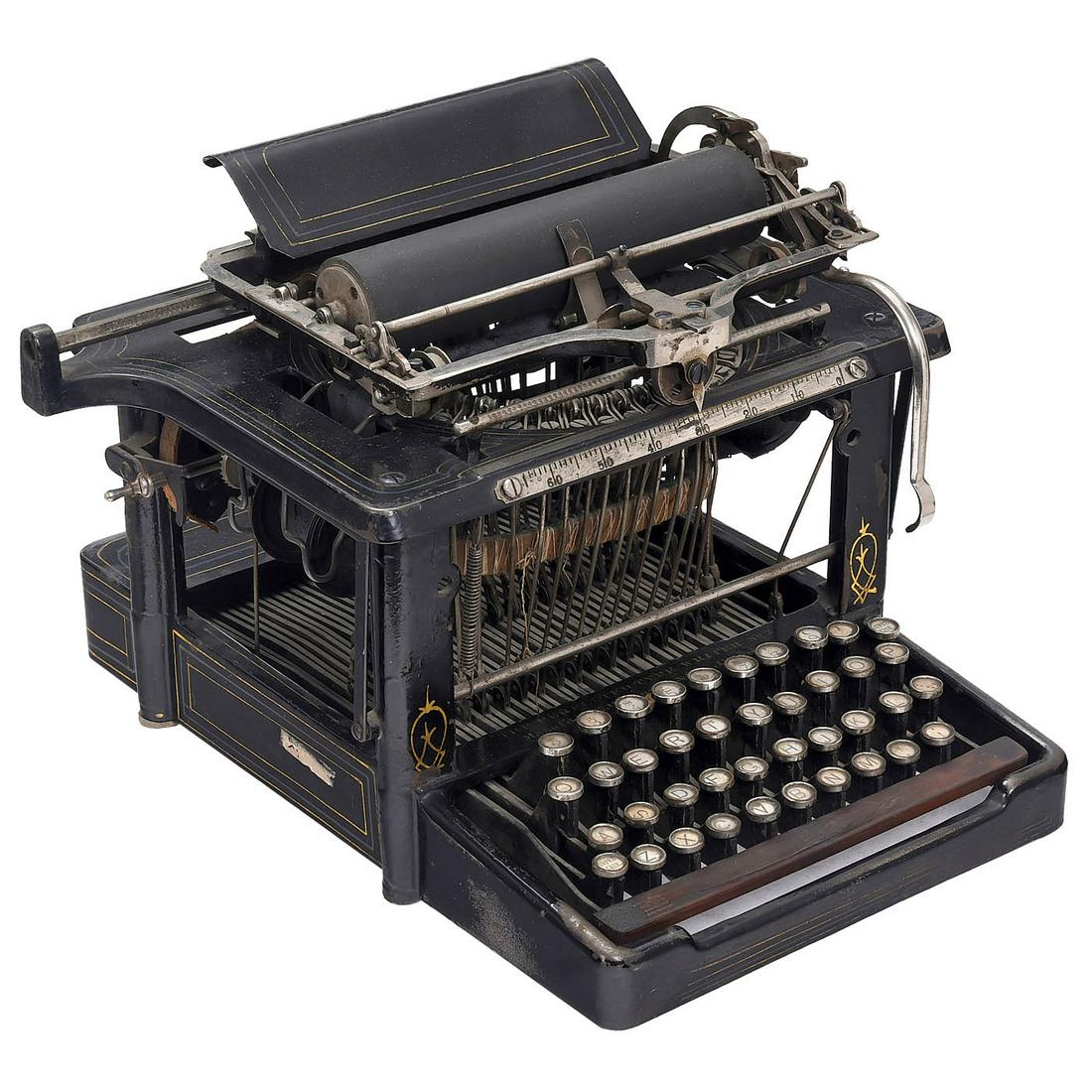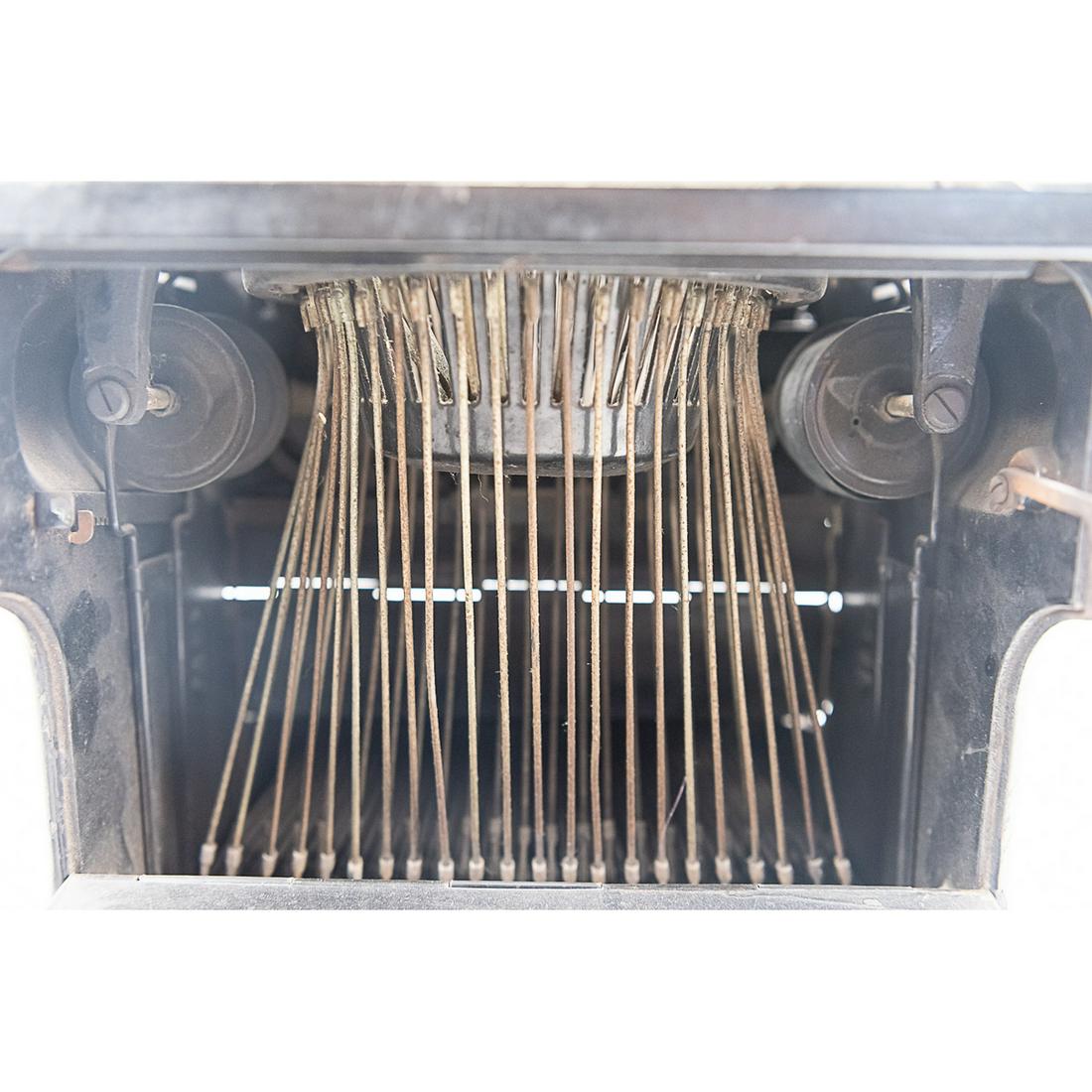Ik kreeg begin oktober 2025 een mailtje van de Stichting Onterfd Goed. Deze stichting kende ik uit 2012 toen ik er enkele typemachines van het voormalig Scryption mocht kopen, of adopteren, zoals ze dat zelf noemden. Het was hun eerste ervaring met het herbestemmen van overtollige collecties. Sindsdien doen ze dat vaker. In de mail stond:
Gemeente Apeldoorn heeft in de loop van heel veel jaren
een kunstcollectie verzameld van ruim 2400 werken. Een deel daarvan stamt uit
de periode waarin kunstenaars in het kader van de Beeldende Kunstenaars
Regeling (BKR) werk inleverden in ruil voor een financiële ondersteuning om
zich te kunnen ontwikkelen. Een ander deel bestaat uit kunstwerken die zijn
aangekocht om kantoren en vergaderruimtes aantrekkelijker te maken.
Met de verhuizing naar een nieuw stadskantoor in het
vooruitzicht, was het noodzakelijk om de totale collectie onder de loep te
nemen. Onterfd Goed ondersteunde de gemeente bij het herzien van het
collectieplan en onderzocht alle werken op conditie, herkomst en historische
waarde. De gemeente besloot 1500 werken af te stoten om te komen tot een goed
beheersbare collectie die ingezet gaat worden in het nieuwe kantoor. In onze
webshop vind je de eerste 400 werken uit deze collectie in 'nieuw
in de webshop'.
 |
| Schilderij Max Geene, 1979 |
Schilderij van Max Geene, 1979
Het schilderij van Max Geene sprong er meteen uit.
Het spreekt mij enorm aan. Wie schildert er nou een
verlaten kruispunt in een grauwe winterochtend? En nog netjes gedaan ook. Na
een paar keer klikken was ik voor 195 euro, inclusief verzending door
gespecialiseerde koerier, de trotse eigenaar van dit schilderij. In de webshop
stond het trouwens verkeerd geregistreerd (het is niet van Gerrit van Dijk,
maar van Max Geene). Bij de beschrijving staat overigens dat het van de gemeente Zwolle afkomstig is en dus niet van de gemeente Apeldoorn.
Het vrij forse schilderij (80 bij 100cm) is waarschijnlijk niet gemaakt met olieverf (zoals in de webshop stond vermeld), maar met acrylverf. Volgens ChatGPT is dat logisch, want “in de jaren ’70 stapten veel realistische schilders over op acryl, vooral in Nederland en Duitsland, omdat het sneller droogde en beter geschikt was voor dat cleane, ‘fotografische’ resultaat. Hyperrealisten en ‘nieuwe realisten’ gebruikten het graag voor stedelijke scènes, reclameborden, asfalt, beton, enzovoort.”
Het schilderij lijkt heel realistisch, maar is niet hyperrealistisch. Het verkeerslicht voor fietsers rechts lijkt te zweven, de schaduwen zijn niet consistent en als je van dichtbij kijkt, zie je veel kleine slordigheden. Vanaf ongeveer 2 meter afstand komt het schilderij daarom het best tot zijn recht. Volgens ChatGPT past het schilderij “bij de Nederlandse tak van het Nieuw Realisme / Stadsrealisme van de jaren ’70, herkenbaar aan dat precieze, bijna koele stadsbeeld, zonder de obsessieve perfectie van hyperrealisme.”
 |
| Realistisch, maar niet hyperrealistisch |
Max Geene, kunstschilder te Overschie
Ik heb niet heel veel over de schilder Max Geene kunnen
vinden. In het krantenarchief staan wel advertenties voor een aantal
tentoonstellingen in de jaren tachtig, maar niet heel veel. Wel vond ik een
interview met hem in Het Vrije Volk (8-7-1986) waarin hij vertelt over het
afschaffen van de BKR-regeling en het leven als kunstenaar in de bijstand. Ik
copy-paste het hele deel dat over hem gaat:
Max Geene, kunstschilder te Overschie, weet wat het is om
als kunstenaar in de bijstand te zitten. Toen hij tien jaar geleden van de
Rotterdamse academie kwam, zag het er een stuk rooskleuriger uit. Een kunstenaar kwam automatisch in aanmerking
voor de BKR. Drie jaar geleden werden er echter inkomenseisen verbonden aan de
regeling. Tegenwoordig moet een kunstenaar een inkomen van 8000 gulden per jaar
aantonen om in aanmerking te komen voor de BKR.
Geene kon vanaf het begin, zoals vele collega's, nlet voldoen
aan de eis en belandde in de bijstand. „Balen. Als kunstenaar in de bijstand je
werk voortzetten, is haast geen doen. Materiaal wordt mondjesmaat aangeschaft. Het
voorzieningsfonds voor kunstenaars springt wel bij, maar de bedragen zijn niet
toereikend om lekker door te werken. Je moet voortdurend schipperen om een
beetje uit te komen met geld. En oppassen dat de situatie je ontwikkeling niet
beperkt. Ik heb wel dagen dat ik het niet meer zie, maar ik wil door. Ik kan
niets anders. Ik zou ook niet meer in te passen zijn in een vaste baan of iets
dergelijks."
Geene heeft zijn atelier in een leegstaande school in
Overschie, een multifunctioneel gebouw. „Daar heb ik geluk mee gehad. Het is
een geschikte ruimte en de huur is laag. Ik kreeg het op het goede moment
aangeboden: mijn zoon begon net te lopen. Ik schilderde eerst thuis, in een
tussenkamer, dat kon niet langer met een peuter.' Als je zo op het minimum
leeft is het heel belangrijk dat ze thuis achter je staan. Ik kan me goed
voorstellen dat sommige kunstenaars die samenwonen of een gezin hebben,
spanningen krijgen door de benarde financiële positie. Daar heb ik gelukkig
niets mee te maken." Volgens Geene kunnen slechts een paar kunstenaars
zich bedruipen. „De mensen kopen niet. Ze zien het en zeggen: goh, aardig. En
vervolgens: moet ik daar dertienhonderd piek voor neerleggen?".
Vóórdat je al aan verkopen kunt gaan denken moet je
trouwens eerst een galerie zover hebben dat ze je werk willen aanbieden. Dan moet
je eerst dure foto's laten maken, een mooi boekje samenstellen en ermee gaan
leuren. Het valt verdomd niet mee".
 |
| Volkskrant, 28 september 1985 |
Henk Elsink, cabaretier
Iets rechts van het
midden staat een bord met het portret van Henk Elsink. Het is al wat
afgebladderd door weer en wind. Henk Elsink speelde met de theatershow “Theater
en Thuis” tussen 6 januari en 14 januari 1979 in het Zuidpleintheater voor het
eerst in Rotterdam. De show zelf was al bijna twee jaar oud. Daarna speelde hij
in Groningen en tussen 23 januari en 3 februari 1979 speelde hij weer in
Rotterdam, nu in het Luxor theater. Voor de première in het Luxor had hij
gratis kaartjes geregeld voor de medewerkers van de Rotterdamse
reinigingsdienst, als bedankje omdat deze de wegen sneeuwvrij hadden gehouden.
De winter
van 1979 was erg streng, met hevige sneeuwstormen. Die van 14 februari 1979
was de ergste ooit, maar ook in de weken daaraan voorafgaand sneeuwde het
regelmatig. Rechts achter het bord met Henk Elsink zijn nog sneeuwresten op het
gras te zien. Het zal dus ergens begin 1979 geschilderd zijn.
Henk Elsink kreeg in de Volkskrant en het NRC overigens heel
slechte recensies. Het NRC (17 januari 1979) schreef bijvoorbeeld dat zijn talent
te beperkt is voor een flitsende show. Ook de vrouwonvriendelijke grappen
vielen niet in de smaak: “wat is het verschil tussen een vrouw en een piano?
Van een piano kun je altijd de klep dichtgooien.” Maar blijkbaar stond dat een
succesvolle twee jaar durende tournee niet in de weg.
Omgeving schilderij en een beetje geschiedenis
Het schilderij is gemaakt net voor het kruispunt tussen de Boezemlaan en de Soetendaalsekade in Rotterdam-Noord. Links is nog net de oprit naar de A20
richting Den Haag en Hoek van Holland zichtbaar, plus een shortcut naar de wijk
Hillegersberg, dat achter de A20 ligt. Die shortcut is er tegenwoordig uit; nu
is er in de plaats daarvan een fietsbrug (Soetendaalsebocht) naast gelegd. De
A20 staat op het schilderij op palen en is voorzien van groene geluidsschermen.
De palen zijn nodig omdat dit deel over de rivier de Rotte heen is aangelegd.
De Rotte zelf is niet zichtbaar, maar stroomt dus onder de A20 door de stad in.
Op bovenstaande satellietfoto uit 2025 is te zien hoe de situatie er tegenwoordig vanuit de lucht uitziet. Op het kaartje eronder geeft het rode rondje het schildersperspectief aan. De schilder stond op het fietspad vanuit de Soetendaalsekade met zijn rug naar het zuiden, net voor de Boezemlaan (aangegeven met groene streepjes op het kaartje). De Rottebrug is aangegeven met het groene vierkantje.
Verderop in dit bericht staan een aantal foto's uit de jaren vijftig en zestig. Het linker pijltje is de plek van waar de drie foto’s uit de jaren vijftig zijn gemaakt, het bovenste kruisje is waar de foto’s uit 1964 en 1970 zijn genomen. Het kleine oranje vierkantje geeft de plek weer waar onderstaande foto uit 1987 is genomen.
 |
| Hetzelfde kruispunt in 1987 |
Als er iets op de foto uit 1987 wordt ingezoomd (zie onder) zijn de overeenkomsten met het schilderij uit 1979 duidelijk te zien. Hoewel de foto net twintig meter verder is genomen, is helemaal links op de foto hetzelfde blauwe bord met de auto erop zichtbaar als op het schilderij. In 1979 was het bord scheef komen te staan; in 1987 was het weer rechtgezet. De overige blauwe verkeersborden lijken in de tussenperiode te zijn vervangen door modernere varianten, maar de locatie en plaatsnamen komen grotendeels nog overeen. De hangende snelwegverlichting boven de A20 hangt er nog, maar de geluidsschermen zijn weggehaald en het kruispunt zelf lijkt in 1987 net onder handen genomen, waarbij de vluchtheuvels en verkeerslichten zijn vervangen. De bomen zijn 8 jaar later ook gegroeid en een stuk groener.
 |
| Schilderij Max Geene 1979 |
 |
| Uitsnede foto Soetendaalsekade 1987 |
Nog eens 38 jaar later is de verkeerssituatie redelijk hetzelfde (op de fietsbrug na), maar lijken alle details aangepast. Alle borden, verkeerslichten, bomen en struiken zijn vervangen en de geluidsschermen langs de A2 zijn weer terug. Alleen de witstalen constructie boven de oprit richting de A20 lijkt nog hetzelfde. Nu dient het niet voor de bewegwijzering, maar voor vierkante matrixborden. Het geheel maakt in 2025 wel een minder opgeruimde en onderhouden indruk dan in 1987.
 |
| Foto van het kruispunt op 14 oktober 2025, gemaakt door Jaap H. |
In 1983 is een luchtfoto van Rotterdam Noord gemaakt waarop ook het geschilderde kruispunt zichtbaar is. Met het kruis staat aangegeven van waar het schilderij moet zijn gemaakt, vier jaar eerder. Het leuke van deze luchtfoto is niet alleen het andere perspectief, maar ook dat deze foto is genomen nog voor de renovatie van het kruispunt, waardoor de situatie op de foto uit 1987 op zoveel details anders werd. Op de luchtfoto uit 1983 is het kruispunt inclusief verkeersborden en -lichten (zover te beoordelen) nog gelijk aan die op het schilderij van 4 jaar eerder.
 |
| Luchtfoto kruispunt Soetendaalsekade (rechts) met Boezemlaan (richting boven) en oprit A20 (links), 1983 |
Op de voorgrond van het schilderij zie je de Boezemlaan naar rechts gaan. Zo’n 100 meter naar rechts is de Rottebrug, want nadat de Rotte onder de A20 doorgaat, moet die ook onder de Boezemlaan door. Op een luchtfoto van 1986 is het kruispunt weer goed zichtbaar. Ook toen was het kruispunt nog niet gerenoveerd. Op deze foto is de Rottebrug met rood omcirkeld.
 |
| Luchtfoto 1986, Rottebrug omcirkeld. |
Van de bouw van zowel de Boezemlaan als de Rottebrug zijn enkele foto’s gemaakt tussen 1955 en 1957. Het geeft een mooi beeld van hoe de omgeving eruit zag voor het door de A20 werd doorsneden. Er was een jachthaven die later verplaatst is. De spoorlijn achter de A20 is helemaal links al wel zichtbaar.
 |
| Bouw van de Rottebrug, 1955 |
 |
| Rottebrug, 1956 |
Leuk detail op bovenstaande foto is dat de putten net zijn aangelegd (trottoirkolken). In onderstaande foto uit 1957 zijn ze terug te vinden bij het zebrapad. Op Google Streetview helemaal op het eind van dit bericht, zijn ze nog steeds terug te vinden in 2025. Zo te zien zijn ze nog origineel.
 |
| Kruispunt Soetendaalsekade met Boezemlaan, 1957. Het schilderij is gemaakt vanaf het rode kruisje. |
De A20 werd in de jaren zestig pas aangelegd. Je kan hier alleen de A20 op richting het westen. Om via de A20 naar Utrecht (het oosten dus) te kunnen moet je de Boezemlaan volgen waarna je via de Bosdreef het knooppunt Terbregseplein op kan draaien, de A20 richting Utrecht op. Je kan op dat knooppunt ook de A16 richting het zuiden (Dordrecht) pakken. Vandaar dat op het blauwe bord links op het schilderij staat dat je rechts de Boezemlaan moet volgen om naar Utrecht of Dordrecht te kunnen rijden. Van de aanleg van de A20 op dit punt zijn ook enkele foto’s gemaakt, ongeveer vanaf de meest linkse boom op het schilderij, gefotografeerd richting het punt waar het schilderij is gemaakt.
 | |
| 1964, foto genomen vanaf de overkant van de Boezemlaan, tussen de op- en afrit naar de A20 |
 | |
| 1970, zelfde perspectief als de foto hierboven, maar dan zes jaar later |
Een gure plek
Omdat de Rotte hier de stad binnenkomt, wordt dit gebied ook wel de Poort van Noord genoemd. De wijk achter de schilder is Het Oude Noorden en aan de overkant van de Rotte ligt Crooswijk. Eind 2020 werd er een prijsvraag uitgeschreven om “de Poort van Noord te agenderen en activeren, de aantrekkelijkheid te vergroten, gebruik uit te lokken en een positieve bijdrage te leveren aan de toekomst van deze plek.” Het winnende initiatief wilde bijvoorbeeld een speeltuin/fitness ruimte aanleggen, net naast de oprit naar de A20 (op het schilderij zou dat net naast de witte stellage met blauwe bewegwijzering zijn). Op Google Streetview van oktober 2024 is dat nog niet terug te zien. Ook de voorgestelde kabelbaan over de Rotte is er nog niet.
 |
| Winnaar prijsvraag Poort van Noord |
Op internet zijn nog andere ambitieuzere plannen te vinden
om het gebied te verbeteren. Zo bestaat er een initiatiefvoorstel
van de PVDA ui 2021, dat voortbouwde op een voorstel uit 2009 om de A20 te overkappen en er een park bovenop te bouwen. De motivatie
achter de verbetering van het gebied is als volgt: “De snelweg is niet alleen
een probleem voor de volksgezondheid, maar splijt bovenal ook prachtige wijken
in het Noorden van de stad. Daarnaast zorgt het voor verschraling in de wegen
direct gelegen aan de snelweg en levert het gure plekken op waar Rotterdammers
in nachtelijke uren niet graag komen.”
Tot nu toe is het voorstel tot overkapping nog niet uitgevoerd; eind 2021 werd besloten om eerst een haalbaarheidsonderzoek te starten. Daarna bleef het stil.
Ik heb het schilderij van deze gure plek opgehangen in mijn
werkkamer.
Tot slot een link naar de huidige situatie:











































